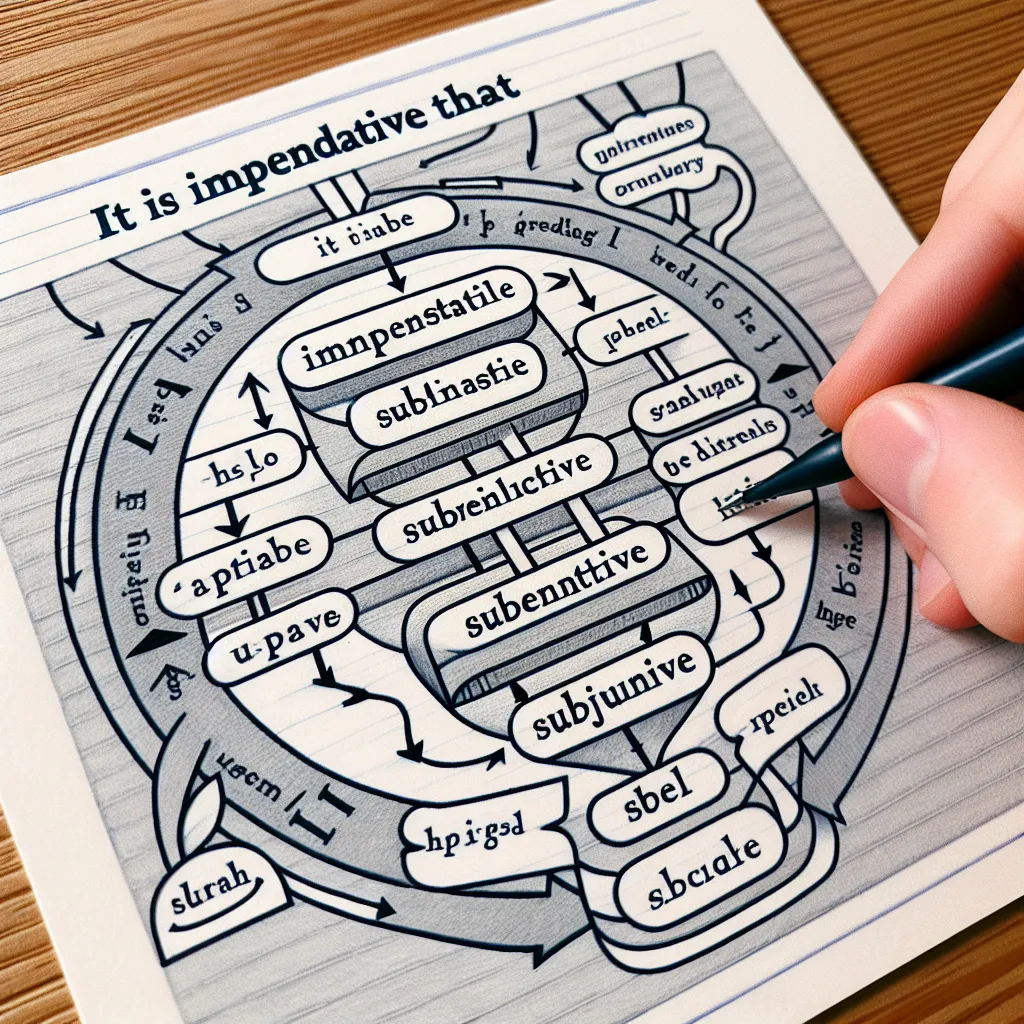The subjunctive mood is a crucial grammatical concept that often appears in IELTS exams, particularly in writing and speaking tasks. One common structure that utilizes the subjunctive is “It is imperative that + subjunctive.” Understanding and mastering this construction can significantly enhance your IELTS performance. Let’s delve into its meaning, usage, and application in IELTS contexts.
Understanding “It is imperative that + subjunctive”
The phrase “It is imperative that” is used to express strong necessity or urgency. When followed by a subjunctive clause, it emphasizes the importance of a particular action or situation. This structure is frequently encountered in formal writing and academic contexts, making it particularly relevant for IELTS candidates aiming for higher band scores.

Grammar Formula and Analysis
The basic formula for this structure is:
It is imperative that + subject + base form of verb
Let’s break down this formula:
- “It is imperative that” serves as the main clause.
- The subject of the subordinate clause follows.
- The verb in the subordinate clause is in its base form (without ‘to’ or any conjugation).
Examples:
- It is imperative that the government take immediate action on climate change.
- It is imperative that students submit their assignments on time.
- It is imperative that every citizen exercise their right to vote.
In each of these examples, note how the verb in the subordinate clause (take, submit, exercise) is in its base form, regardless of the subject.
Application in IELTS Writing
Using “It is imperative that + subjunctive” effectively in your IELTS Writing task can demonstrate a high level of grammatical proficiency. Here are some examples of how you might incorporate this structure into different IELTS Writing Task 2 topics:
Environment
It is imperative that governments worldwide implement stricter regulations on industrial emissions to combat global warming.
Education
It is imperative that educational institutions provide students with practical skills alongside theoretical knowledge to prepare them for the job market.
Technology
It is imperative that individuals remain vigilant about their online privacy and take necessary precautions to protect their personal data.
Health
It is imperative that healthcare systems adapt to the growing needs of aging populations in developed countries.
Economy
It is imperative that developing nations diversify their economies to reduce dependence on a single industry or resource.
Enhancing IELTS Speaking Performance
In the IELTS Speaking test, using “It is imperative that + subjunctive” can showcase your advanced language skills. Here are some examples of how you might use this structure in different parts of the speaking test:
Part 2 (Cue Card)
Topic: Describe an important decision you made.
“…When I was choosing my university major, it was imperative that I select a field that not only aligned with my interests but also offered good career prospects…”
Part 3 (Discussion)
Question: How can governments encourage young people to make better lifestyle choices?
“I believe it is imperative that governments invest in comprehensive education programs. Moreover, it is imperative that they create policies that make healthy options more accessible and affordable for young people.”
Common Mistakes and How to Avoid Them
When using “It is imperative that + subjunctive,” IELTS candidates often make the following mistakes:
-
Using ‘to’ before the verb:
Incorrect: It is imperative that the company to reduce its carbon footprint.
Correct: It is imperative that the company reduce its carbon footprint. -
Conjugating the verb:
Incorrect: It is imperative that every employee follows the new safety protocols.
Correct: It is imperative that every employee follow the new safety protocols. -
Using modal verbs:
Incorrect: It is imperative that we must act now.
Correct: It is imperative that we act now.
To avoid these errors, always remember to use the base form of the verb without any additions or conjugations.
Alternatives and Variations
While “It is imperative that” is a powerful structure, it’s important to have a range of expressions at your disposal. Here are some alternatives that can help you vary your language:
- It is essential that…
- It is crucial that…
- It is vital that…
- It is necessary that…
- It is of utmost importance that…
For example:
- It is essential that developing countries receive adequate support to adapt to climate change.
- It is crucial that international cooperation be strengthened to address global challenges.
Achieving Higher Band Scores
To achieve higher band scores in IELTS, it’s not just about using complex structures like “It is imperative that + subjunctive,” but using them accurately and appropriately. Here’s how you can leverage this structure for different band scores:
Band 6-6.5
At this level, you might use the structure occasionally but with some errors:
“It is imperative that the government do something about pollution.”
Band 7-7.5
You would use the structure more confidently and accurately:
“It is imperative that the government take concrete steps to reduce pollution levels in urban areas.”
Band 8-9
At this level, you would use the structure flawlessly and combine it with other advanced language features:
“Given the alarming increase in air pollution levels, it is imperative that governments not only implement stricter emissions standards but also incentivize the use of renewable energy sources.”
Conclusion
Mastering the “It is imperative that + subjunctive” structure can significantly enhance your IELTS performance, particularly in Writing and Speaking tasks. By understanding its grammatical rules, practicing its application in various contexts, and avoiding common mistakes, you can effectively demonstrate a high level of English proficiency. Remember to use this structure alongside a variety of other advanced grammatical forms to showcase the full range of your language skills in the IELTS exam.
For further practice, try incorporating this structure into essays on topics such as environmental protection, educational reform, technological advancements, or global economic challenges. The more you use it in context, the more natural and effective your usage will become in the actual IELTS test.